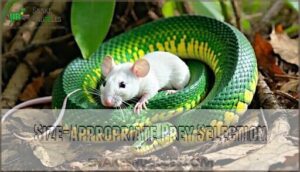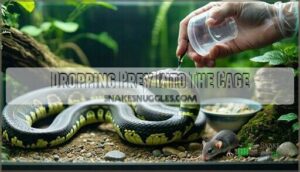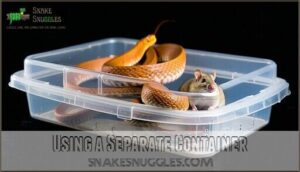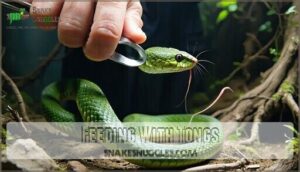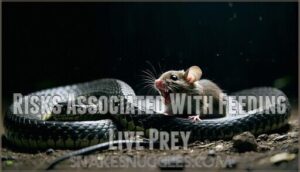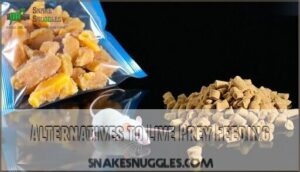This site is supported by our readers. We may earn a commission, at no cost to you, if you purchase through links.
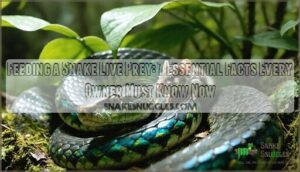
Live prey lets your snake use its hunting instincts, which can stimulate appetite and encourage natural behaviors. However, it comes with risks, like injuries to your snake if the prey fights back, or the potential for parasites.
Ethical concerns and convenience also play a role—many owners find frozen-thawed prey safer and simpler. If you do go the live route, monitor the feeding closely to keep things under control.
Choosing the right prey size and species is critical too—big meals can harm your snake. There’s more to this than meets the eye!
Table Of Contents
- Key Takeaways
- Benefits of Live Prey
- Disadvantages of Live Prey
- Live Prey Vs. Frozen Prey
- Choosing The Right Prey
- Feeding Techniques for Live Prey
- Encouraging Stubborn Snakes to Eat
- Prey Selection for Different Snake Species
- Risks Associated With Feeding Live Prey
- Preparing for Live Prey Feeding
- Alternatives to Live Prey Feeding
- Frequently Asked Questions (FAQs)
- Should you feed live prey to snakes?
- Is it illegal to feed live mice to snakes in the US?
- How to get a snake to eat live food?
- Should I Feed my pet snake pre-killed prey?
- Should you feed a snake live food?
- Should pet snakes eat live or frozen prey?
- What do snakes eat?
- Is it better to feed snakes live or frozen?
- Do any snakes eat their prey alive?
- What not to do when feeding a snake?
- Conclusion
Key Takeaways
- Monitor feedings closely because live prey can injure your snake or carry parasites.
- Choose prey sized appropriately for your snake to prevent digestion issues and injuries.
- Frozen-thawed or pre-killed prey is safer, easier, and more humane while still meeting your snake’s dietary needs.
- Live prey stimulates natural hunting instincts but comes with higher risks and ethical concerns.
Benefits of Live Prey
You’ll find that feeding live prey to your snake provides higher nutrient density and better stimulates their natural hunting instincts.
Feeding live prey enhances nutrient absorption and triggers instinctive hunting behaviors, promoting a healthier, more engaged snake.
Live prey retains more vitamins and minerals compared to frozen alternatives, while also encouraging natural behaviors that can reduce stress in your pet snake.
Nutrient Density
In terms of nutrient density, live prey offers your snake substantial nutritional advantages over frozen alternatives.
Live prey delivers unmatched nutrient density, keeping vitamin levels intact and supporting your snake’s natural health and hunting instincts.
Live feeding mimics your snake’s natural diet, maximizing bioavailability of essential nutrients.
Four key whole prey benefits include:
- Higher vitamin content that remains intact without degradation from freezing
- Enhanced mineral absorption due to preserved enzyme activity
- Superior protein quality with complete amino acid profiles
- Improved digestion efficiency from natural feeding responses.
This nutritional powerhouse often reduces supplement necessity, as your snake receives a complete package of nutrients exactly as nature intended.
For peak health, consider how live prey can satisfy your snake’s evolutionary dietary needs.
Stimulates Appetite
When feeding a snake live prey, the natural movement instantly triggers hunting instincts, stimulating appetite in ways frozen alternatives can’t match.
Live prey’s natural appeal helps reduce stress for fussy eaters who might ignore motionless food.
The wiggling, scurrying, and warmth mimic what snakes encounter in nature, making feeding time more engaging.
For particularly stubborn snakes, this appetite stimulation often resolves feeding issues that frustrate many owners, providing a solution to common problems related to appetite stimulation.
Encourages Natural Behavior
Live prey offers your snake essential enrichment by triggering natural hunting instincts that captive reptiles rarely experience.
When snakes stalk, strike, and constrict live prey, they’re exercising both body and mind, much like their wild counterparts.
This captivity enrichment contributes substantially to overall snake wellbeing and satisfaction.
The movement, scent, and temperature of live prey create a complete sensory experience that frozen alternatives simply can’t match.
Just remember to weigh the benefits against potential risks.
Easier to Feed Fussy Snakes
When your snake refuses frozen meals, live prey often saves the day.
The natural movement triggers hunting instincts in even the fussiest eaters, especially wild-caught specimens.
Live prey works wonders because:
- The wiggling movements instantly spark your snake’s predatory drive
- The scent and warmth create an irresistible natural appeal
- The hunting experience reduces stress by satisfying deep-rooted instincts
For stubborn snakes facing feeding challenges, live prey stimulation often succeeds where other methods fail, providing a solution that can satisfy the snake’s need for live prey.
Disadvantages of Live Prey
You’ll face significant risks when feeding your snake live prey, including potential injuries from defensive rodents and transmission of harmful parasites or diseases.
Live prey also requires more storage space, costs more money, and raises ethical concerns about animal welfare that many snake owners find troubling, including issues related to animal welfare.
Injuries and Infections
While natural feeding has benefits, it comes with serious risks.
Defensive rodents can inflict severe bite wounds on your snake, damaging eyes, mouth, and organs.
These injuries often lead to infection that can be fatal without proper veterinary intervention.
Never leave live prey unsupervised with your snake—those tiny teeth can quickly cause devastating damage requiring expensive treatment.
If you notice any injuries, seek immediate medical care to prevent complications and guarantee your snake’s recovery.
Parasites and Diseases
Beyond injuries, those wriggling rodents carry hidden dangers. Live prey often harbors parasites and diseases that threaten both your snake and you.
4 key zoonotic risks to keep in mind:
- Hantavirus from rodent droppings
- Salmonella transmission through handling
- Rat-bite fever affecting humans and reptiles
- Various parasites like mites and tapeworms
Freezing prey eliminates these threats, making frozen options substantially safer than live feeding while requiring no veterinary intervention.
Inconvenience of Storage
Beyond the risk of parasites comes another challenge: storing live prey isn’t just inconvenient—it’s a full-time commitment.
You’ll face ongoing challenges with live prey storage—from space requirements to odor control and the constant fear of escapees. Many owners find frozen-thawed rodents offer similar nutritional benefits without these headaches.
| Storage Factor | Live Prey | Frozen-Thawed |
|---|---|---|
| Space Constraints | Separate cages required | Simple freezer storage |
| Odor Control | Daily cleaning needed | No ongoing smell |
| Escape Risks | High without secure cages | None |
| Maintenance Labor | Feeding, watering daily | Minimal handling |
The use of live prey storage presents several issues, including the need for secure cages to prevent escape, making frozen-thawed options a more convenient alternative for many.
Higher Cost
Straining your budget, live prey feeding typically costs substantially more than frozen alternatives.
When comparing expenses, live rodents for snakes can run 30-50% higher than pre-killed options. This price difference adds up quickly, especially with larger snake species requiring multiple feedings.
Breeding vs buying presents another consideration – maintaining a rodent colony demands space, food, and cleaning supplies. Long-term expenses include regular trips to pet stores and potentially higher veterinary bills from prey-related injuries.
Consider these budgeting strategies: bulk purchasing frozen prey, joining reptile clubs for discounts, or exploring cost-justified alternatives like commercial snake foods for substantial savings.
Ethical Concerns
Moving beyond the financial impact, ethical concerns touch on deeper values you hold as a responsible snake owner.
When feeding live prey, you’re confronting real questions about animal welfare.
Consider these ethical dimensions:
- Prey suffering – rodents experience fear and pain without escape options
- Unnecessary cruelty – most captive snakes adapt well to pre-killed alternatives
- Owner responsibility – your choices affect two animals’ wellbeing
- Wild behavior – justification often centers on "natural" hunting
- Justification debate – whether convenience outweighs welfare concerns
Live Prey Vs. Frozen Prey
You’ll face an important choice between live prey that stimulates natural hunting behaviors and frozen-thawed options that offer safety and convenience.
While live prey provides slightly better nutrition and encourages your snake’s instincts, frozen prey eliminates injury risks and simplifies your feeding routine, offering convenience.
Nutrient Retention
While live prey presents risks, it offers significant nutrient benefits for your snake.
The freezing process can diminish certain vitamins in prey items, though the impact is minimal with quality sources.
| Nutrient Factor | Live Prey | Frozen Prey |
|---|---|---|
| Vitamin retention | Higher | Slightly lower |
| Protein quality | Unaltered | Slightly degraded |
| Digestibility | Excellent | Very good |
| Storage impact | None | Minimal loss |
| Supplement needs | Lower | Slightly higher |
Most snakes thrive equally well on either option when properly prepared, and the choice between live and frozen prey can be made based on the slightly lower vitamin retention in frozen prey, and the excellent digestibility of live prey, considering the minimal loss in storage impact.
More Natural Diet
While frozen prey retains many nutrients, offering live prey mirrors a snake’s Wild Diet more accurately.
When you provide live food, you’re supporting your snake’s Natural Behaviors and Instinctual Needs. The movement triggers natural hunting instincts, creating an enriching experience that frozen options simply can’t match.
| Aspect | Natural Diet Benefit |
|---|---|
| Hunting Behavior | Exercises predatory skills |
| Mental Stimulation | Reduces captivity stress |
| Feeding Response | Triggers stronger appetite |
| Dietary Enrichment | Mimics wilderness experience |
| Nutritional Completeness | Preserves all natural nutrients |
This snake feeding behavior satisfies both physical and psychological needs.
Vitamin Absorption
When comparing live and frozen prey, vitamin absorption stands out as a critical factor for your snake’s health.
Live prey typically offers superior bioavailability of essential nutrients.
| Vitamin | Live Prey | Frozen Prey | Benefit for Snakes |
|---|---|---|---|
| Vitamin A | Higher levels | Degraded | Vision health |
| Vitamin D | Naturally present | Often diminished | Calcium metabolism |
| Vitamin K | Abundant | Reduced | Blood clotting |
| Fat-soluble | Better absorbed | Less bioavailable | Gut microbiome support |
Different snake species have varying requirements, but most benefit from the enhanced nutrient profile that live feeding provides, which supports overall health and well-being.
Health Benefits
The health advantages of offering live prey to your snake mirror nature’s blueprint for ideal wellness.
Live feeding enhances nutrient absorption and supports digestive processes that evolved over millions of years.
These natural hunting instincts, when satisfied, often result in fewer digestive issues and stronger skeletal development.
| Benefit | Live Prey | Frozen Prey |
|---|---|---|
| Digestive Health | Superior | Adequate |
| Bone Health | Excellent | Good |
| Immune Function | Enhanced | Maintained |
The health advantages and natural hunting instincts are key to understanding the benefits of live prey for snakes, which include digestive issues and stronger skeletal development.
Choosing The Right Prey
You’ll need to match your snake’s size and species with the correct prey to guarantee proper nutrition and prevent feeding issues.
Selecting appropriate prey size prevents injury while offering variety mimics their natural diet and keeps your snake healthy.
You’ll need to ensure the prey size is correct to avoid any issues.
Species-Specific Diet Requirements
Understanding your snake’s species-specific diet requirements is the foundation of proper nutrition.
While frozen prey offers convenience, knowing what your snake naturally eats is essential.
Different species have unique nutritional needs—ball pythons prefer rodents, while garter snakes may eat fish and amphibians.
Research your specific species’ dietary diversity and feeding frequency requirements.
Consider prey size based on your snake’s size, and be cautious with supplements as over-supplementation can cause health problems.
Size-Appropriate Prey Selection
Selecting the right prey size is vital for your snake’s health.
Choose prey that measures 10-15% of your snake’s body weight to match its gape and guarantee proper digestion efficiency.
A mouse too large risks regurgitation, while undersized prey won’t support ideal growth rates.
As your snake develops, gradually increase prey size from pinkies to adult rodents.
Pay attention to how easily your snake consumes its meal—if it struggles, downsize immediately.
Remember, proper prey selection prevents digestive issues and supports your snake’s natural feeding patterns.
Food Variety Importance
Now that you’ve matched prey size to your snake, don’t overlook variety in their diet. Just like you wouldn’t eat the same meal every day, your snake benefits from prey rotation.
A varied diet guarantees better nutrient balance and prevents feeding boredom. Different snake species have unique dietary preferences, so consider these factors:
- Rodent variety (mice, rats, gerbils)
- Occasional bird options (quail, chicks)
- Alternative prey based on species needs
- Seasonal rotation mimicking natural feeding patterns
This dietary diversity supports peak snake nutrition and feeding response.
Feeding Techniques for Live Prey
You’ll need to master proper feeding techniques to guarantee both your snake and the prey remain safe during the feeding process.
Using the right approach, such as feeding with tongs or in a separate container, will help prevent injuries and create a successful feeding routine.
Dropping Prey Into The Cage
Now that you’ve selected the right prey for your snake, you’ll need to ponder how to offer it.
Dropping live prey directly into the cage requires careful monitoring. When you introduce the rodent, watch your snake’s immediate response to prevent potential injuries from prey fighting back.
The cage environment should minimize prey escape opportunities while reducing stress for your snake. Consider using specialized feeding containers to guarantee a safer feeding process.
Never leave live prey unattended—it’s a recipe for disaster.
Using a Separate Container
For safe live prey feeding, a separate container serves as your controlled feeding arena.
Using this method substantially reduces stress for your snake while providing essential safety benefits.
- Escape prevention becomes easier with proper container selection – choose one that’s 1-2 times your snake’s length with secure, ventilated lid
- Reduced substrate ingestion keeps your pet healthier by eliminating accidental bedding consumption
Select a container with adequate space but not so large that your snake wastes energy searching for prey.
Consider using a specialized feeding container for ideal safety.
Clean thoroughly after each feeding to prevent bacterial buildup.
This approach allows for better monitoring feeding behavior and simplifies cleaning ease.
Many experienced keepers prefer this method as it creates a designated feeding zone without endangering your snake on enclosure decorations.
Feeding With Tongs
After moving your snake to a separate feeding container, tongs become your best ally for safe feeding. Using proper feeding tongs keeps your fingers at a safe distance and prevents your snake from associating your hand with food.
When handling live prey, grip it firmly by the base of the tail with stainless steel or plastic tongs. Size matters—choose tongs that match your snake’s size and your grip strength. Too short exposes you to danger; too long reduces your control.
To avoid accidental bites, it’s vital to understand why use feeding tongs. For maximum safety, practice your handling techniques before attempting to feed. This builds confidence and makes smoother feeding sessions for both you and your pet, ensuring a successful and stress-free experience.
Encouraging Natural Hunting Behavior
Throughout your snake’s life, encouraging natural hunting behavior creates essential mental stimulation that reduces stress and improves overall health.
To enhance instinctual feeding experiences, consider the following steps:
- Create environmental enrichment by adding branches, hiding spots, and varied substrates
- Introduce prey at different times and locations in the enclosure
- Use feeding tongs to mimic live prey movement, triggering your snake’s predatory response
Consider incorporating safe habitat accessories to further stimulate your snake. This behavioral enrichment supports your snake’s natural diet needs while providing enriching activity.
Encouraging Stubborn Snakes to Eat
You’ll find that stubborn snakes often need extra encouragement through motion stimulation and environmental adjustments to trigger their feeding response.
Try wiggling prey with feeding tongs and verify your snake’s enclosure temperature is ideal, as these simple techniques can transform a reluctant eater into a motivated one.
Using Tongs to Stimulate Appetite
With tongs, you’ll easily entice stubborn snakes to feed.
Mimicking natural hunting movements, gently wiggle the prey to trigger your snake’s predatory instincts. The tongs create safe distance, reducing stress for both you and your pet.
Technique Success Rate
This method gives you complete control, making live prey feeding safer and more successful.
Offering a Variety of Prey
When using tongs doesn’t work, offering prey variety can turn things around.
Snakes, like humans, don’t always want the same meal. Prey rotation—switching between mice, rats, chicks, and other items—can match their wild diet while supporting nutrient balance.
Enrichment feeding also keeps them curious. Dietary diversity satisfies snake prey preferences and also guarantees better health.
Always pick appropriately sized prey for safe and easy snake feeding live.
- Try these tips:
- Rotate between mice, rats, and chicks.
- Balance nutrition with different prey types.
- Observe preferences to adjust offerings.
- Use prey sizes matching your snake’s needs.
Ensuring a Comfortable Environment
A relaxed snake is a happy eater.
Get the enclosure size right—too big and they’ll feel lost, too small and stressed.
Balance temperature gradients and humidity levels to mimic natural habitats.
Substrate choice matters; think soft and snug.
Add hiding spots—they love those secret retreats!
Comfort lowers live prey risks and supports snake safety during feeding.
Superior conditions include maintaining the correct humidity levels to prevent shedding problems.
See the quick guide below for tips:
| Factor | Good for Snakes? | Tips |
|---|---|---|
| Enclosure size | Absolutely key! | Match their length, not oversize. |
| Temperature | Key for appetite | Gradient zones: warm to cool. |
| Hiding spots | Always helpful | One per snake, dark and safe. |
Prey Selection for Different Snake Species
Choosing the right prey for your snake depends on its species, size, and natural diet. Matching prey to your snake’s needs guarantees proper nutrition and promotes healthy feeding behavior.
Species-Specific Prey Requirements
Snakes aren’t picky eaters—they’re specialists! Each species has unique dietary needs shaped by evolution. Understanding their species-specific diet helps you match prey to their natural diet.
Dietary diversity supports a snake’s health, but always prioritize prey matching their size and swallowing ability. Ball pythons love small rodents, while garter snakes favor insects or fish.
- Choose prey matching your snake’s hunting style and size.
- Larger constrictors need bigger meals; smaller species prefer tiny snacks.
- Maintain nutritional balance with varied, natural prey.
- Avoid over-supplementation unless recommended.
- Observe your snake’s eating habits.
Age and Size Considerations
Always match prey size to your snake’s age and girth—think hatchlings need baby-sized bites, juveniles grow into larger meals, and adults take hefty prey.
Too small? They’ll stay hungry. Too big? Overfeeding risks digestion trouble.
Baby snakes thrive on frequent, tiny feedings, while adults need fewer meals. Watch for underfeeding signs like weight loss and adjust prey based on their growth and feeding response to prevent digestion trouble.
Prey Preferences
Your snake’s natural instincts and species will shape its prey preferences.
Some thrive on rodents, while others crave amphibians or smaller reptiles, mimicking wild diets.
Keep pace with your snake’s scent preferences and occasional taste variation to prevent food aversion during live prey feeding.
Size matters—your snake’s prey should be no larger than its midsection.
Experiment with variety and monitor reactions.
Balancing health with instinctual needs guarantees smarter snake prey selection and keeps their live prey menu as natural as possible!
Risks Associated With Feeding Live Prey
Feeding your snake live prey might seem natural, but it comes with serious risks.
From injuries caused by defensive rodents to potential disease transmission, understanding these dangers is essential for your snake’s safety.
Zoonotic Parasites
Feeding live prey can invite unwanted guests into your home—zoonotic parasites.
These pests, like Salmonella, threaten human health and snake immunity. Handling live prey increases zoonotic transmission risks, exposing you to infections and snake parasites.
Stay vigilant with parasite prevention: wash hands, sanitize enclosures, and schedule veterinary care. Managing zoonotic parasites keeps disease transmission low while safeguarding both you and your pet snake.
Disease Transmission
When feeding live prey, you’re not just introducing dinner—you might also be inviting trouble.
Rodents often carry zoonotic diseases like Salmonella, Rat-bite fever, or Leptospirosis.
These parasite vectors can lead to bacterial infections in your snake or even you.
To minimize disease transmission and viral risks, use prevention methods like handling prey carefully, maintaining cleanliness, and consulting experts about managing zoonotic parasites.
Switching to frozen-thawed rodents can eliminate physical injury risks for your snake, which is a significant consideration for managing zoonotic parasites.
Preparing for Live Prey Feeding
Before feeding your snake live prey, make sure you’ve prepared a safe feeding environment and proper housing for the prey.
Taking precautions like supervising feedings and using tools can help protect both your snake and yourself, which is a crucial part of creating a safe environment.
Housing and Storage
Properly housing rodents for live prey storage guarantees safety and cleanliness. Use a secure enclosure with adequate ventilation and temperature control.
Maintain humidity levels and select an easy-to-clean substrate. Follow these tips:
- Choose an escape-proof enclosure.
- Keep cleaning protocols consistent.
- Monitor temperature and humidity closely.
- Guarantee a pest-free environment for rodent health.
Good housing means happier, healthier prey, which is essential for healthier and happier animals.
Feeding and Handling
- Secure your snake’s enclosure to prevent prey escape or harm. A tight, well-fitted lid is non-negotiable.
- Select live rodents sized appropriately for safe feeding. Prey too large can injure your snake.
- Always use tongs for handling prey; keeping your hands safe avoids accidents and guarantees clean feeding.
- Maintain hygiene practices by cleaning the feeding area thoroughly. Poor cleanliness invites disease—neither you nor your snake needs that hassle!
Live prey’s nutrition can boost a snake’s immune system.
Safe live feeding guarantees both owner safety and a healthy snake, which is essential for healthy snake care.
Safety Precautions
When prepping for safe live feeding, don’t overlook the basics. Start by cleaning the enclosure to keep bacteria at bay.
Use tongs during handling to avoid those tricky rodent bites—your fingers will thank you. Double-check your enclosure’s security to prevent any unexpected rodent escapes.
Keep a first-aid kit handy for bite prevention, just in case. Post-feeding care includes ensuring your snake isn’t stressed or injured.
Feeding risks are real, but these handling techniques and snake feeding precautions can reduce injuries and make live feeding safer for everyone involved, with proper prevention.
Alternatives to Live Prey Feeding
You don’t have to rely on live prey to keep your snake healthy and well-fed.
Options like frozen-thawed prey, pre-killed meals, and commercial snake food provide safe, convenient, and effective alternatives.
Frozen Prey Options
Switching gears to frozen prey options makes feeding simpler and safer. Here’s why many snake owners prefer them:
- Thawing Methods: Warm frozen prey in water to mimic body heat.
- Storage Duration: Keeps for months in the freezer.
- Nutritional Value: Comparable to live prey, without risks.
- Safety Concerns: Frozen-thawed rodents eliminate bites or disease worries.
Pre-Killed Prey
If live feeding isn’t for you, pre-killed prey offers a perfect compromise.
It’s safer, addresses ethical concerns, and aligns with animal welfare.
Storage solutions are easy—just freeze and use effective thawing methods to retain nutrients.
And if your snake’s picky, try scent imitation by wiggling the prey gently.
This tactic makes frozen-thawed rodents irresistible, offering a reliable alternative to live feeding.
Commercial Snake Foods
If live prey feels like a hassle, commercial snake foods might be the answer.
These specially-formulated options make snake care easier while meeting their nutritional needs.
Here are three tips:
- Compare commercial brands for the best balance of nutritional content and cost analysis.
- Always follow storage guidelines for food safety.
- Supplement diet variety sparingly for better snake feeding results.
Frequently Asked Questions (FAQs)
Should you feed live prey to snakes?
Feeding live prey to snakes simulates their natural hunting instincts, but it’s risky.
Live prey can injure your snake and carry diseases.
Most snakes thrive on frozen-thawed prey, which is safer, cost-effective, and ethically preferred.
Is it illegal to feed live mice to snakes in the US?
Feeding live mice to snakes isn’t illegal across the U.S., but some states or cities prohibit it due to animal cruelty laws.
Always check local regulations to verify you’re following the rules.
How to get a snake to eat live food?
Create a calm environment, use appropriately sized prey, and simulate movement with feeding tongs to spark hunting instincts.
Don’t rush; some snakes need patience.
If it’s stubborn, consult a reptile vet for specialized advice.
Should I Feed my pet snake pre-killed prey?
Pre-killed prey is safer, more convenient, and reduces risks like injuries or diseases.
It’s easier to store, eliminates ethical concerns, and most snakes adapt well.
Always match prey size to your snake’s needs for proper nutrition.
Should you feed a snake live food?
Did you know live prey can transmit diseases like Salmonella to your snake?
While it mimics natural hunting, it’s risky for injuries and infections.
Frozen-thawed options are safer, humane, and easier to manage.
Should pet snakes eat live or frozen prey?
It depends on your snake’s needs and your preferences.
Frozen prey is safer, more convenient, and humane, while live prey stimulates hunting instincts but carries risks.
Always research your snake’s species-specific diet to decide wisely.
What do snakes eat?
Snakes eat whole prey like mice, rats, birds, or reptiles based on their species.
They rely on this diet for proteins, fats, and essential nutrients.
Always match prey size to your snake’s size for safety.
Is it better to feed snakes live or frozen?
Frozen prey is safer, more convenient, and reduces risks of injury or disease.
Live prey stimulates natural instincts but can harm your snake.
Choose based on your snake’s needs, species, and your ability to supervise.
Do any snakes eat their prey alive?
Many snakes eat their prey alive, especially in the wild.
They strike, constrict, and swallow the prey whole, relying on natural instincts.
It’s not pleasant, but it’s how they survive and thrive in nature.
What not to do when feeding a snake?
Don’t leave prey unsupervised, overfeed, or offer prey that’s too large.
Avoid direct hand-feeding to prevent bites.
Never rush feeding—stress can cause refusal.
Stick to proper prey size and follow sanitation practices diligently.
Conclusion
At the end of the day, feeding a snake live prey has its pros and cons.
While it taps into your snake’s natural instincts and promotes healthy behavior, it also carries risks like injuries, parasites, and ethical concerns.
Always monitor feedings and choose appropriately sized prey to keep your snake safe and healthy.
Frozen or pre-killed options may be safer and more convenient for many owners.
Your snake’s well-being depends on informed decisions, so weigh your options carefully.





